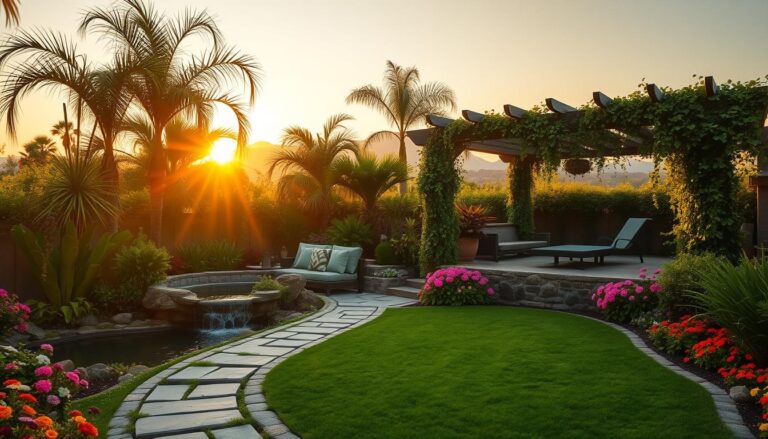DIY Gardening Projects: Create Your Dream Outdoor Oasis
This post contains affiliate links, meaning I may receive a small commission if you make a purchase through my links, at no extra cost to you.
Imagine stepping into your own serene outdoor retreat. Lush greenery and vibrant flowers take you to a world of peace. Turning your backyard into a dream garden is simpler than you might think. With creativity and the right materials, your backyard can become an outdoor oasis that shows off your style.
Begin by looking at your outdoor space and thinking about what you want. Consider the mood you want to create and what makes your space special. This way, you’ll make a space that looks great and feels like part of your home.
Key Takeaways
- Create a clear vision for your outdoor space
- Assess your current outdoor space
- Choose the right materials for your DIY project
- Consider the ambiance you want to create
- Add personal touches to make your outdoor space special
- Start small and be patient with your DIY project
Why DIY Gardening Projects Are Perfect for Everyone
DIY gardening lets you turn your gardening ideas backyard into reality. It’s more than a hobby; it’s a way to relax, stay active, and connect with nature.
Gardening has many benefits. It can lower stress and anxiety, boost mental health, and offer a chance to exercise. DIY gardening projects help you create a peaceful space that’s good for your well-being.
Benefits of Gardening
Gardening is great for both your body and mind. It can:
- Reduce stress and anxiety
- Improve mental health
- Offer a chance to exercise
- Give you a sense of accomplishment and pride
Customization Options
DIY gardening lets you customize your garden design however you like. You can pick the plants, materials, and layout that fit your style.
Whether you want a modern or traditional garden, DIY projects make it possible. You can also use old materials to create unique garden features.
Cost-Effective Solutions
DIY gardening is often cost-effective. You can reuse materials like old pallets and crates. This way, you can make your garden beautiful and functional without spending a lot.
Doing the work yourself also saves money on labor. It gives you a sense of pride and accomplishment in your garden.
Essential Tools for DIY Gardening
Having the right tools is key for DIY gardening. Whether you’re new or experienced, the right tools can greatly improve your gardening success.
Basic Tools Every Gardener Needs
Every gardener needs basic tools to start. You’ll need a trowel for planting, pruners for trimming, and a watering can for watering. These tools help keep your garden healthy and your plants growing well.
- A trowel for digging and planting
- Pruners for trimming and shaping plants
- A watering can for efficient watering
- Gardening gloves for protection
Advanced Tools for Enthusiasts
For those wanting to improve their gardening, advanced tools are great. You might need a garden tiller for soil, a greenhouse for climate control, or a drip irrigation system for watering.
| Tool | Description | Benefit |
|---|---|---|
| Garden Tiller | Prepares soil for planting | Improves soil quality |
| Greenhouse | Controls climate and temperature | Extends growing season |
| Drip Irrigation System | Delivers water directly to roots | Conserves water and reduces waste |
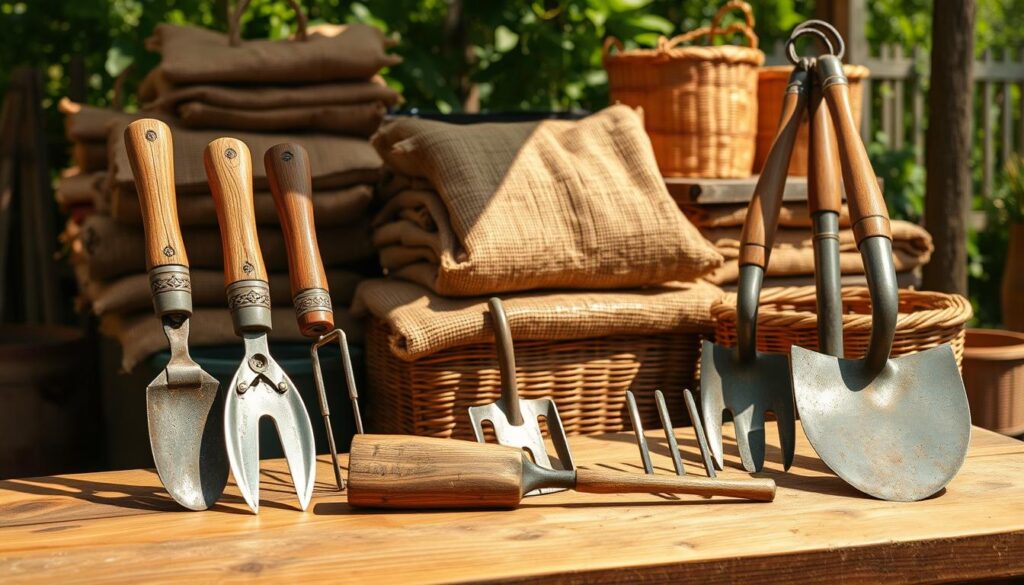
Investing in the right tools can make your DIY gardening better. Whether you’re making a diy green house or starting a herb garden, the right tools will help you succeed.
Planning Your Garden Space
Planning your garden is more than picking plants. It’s about making a space that fits your life and looks great. Whether it’s a Homesteading Garden Layout or a Veggie Garden Layout, planning is key.
Assessing Your Environment
Before designing your garden, know your environment. Check the sunlight, soil, and climate. This helps pick the right plants and design a thriving garden.
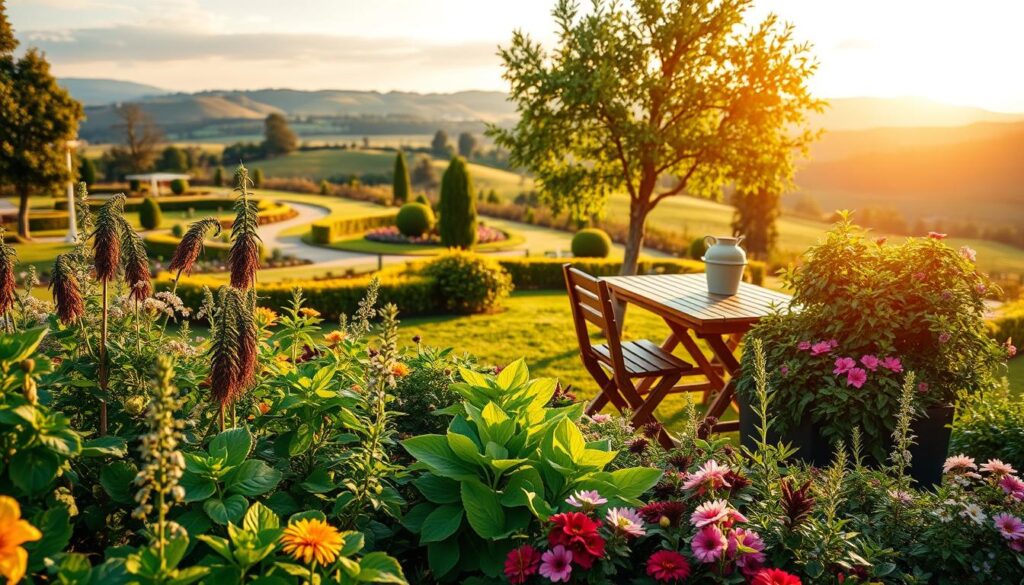
Designing the Layout
After knowing your environment, design your garden. Think about the space and how you’ll use it. Do you want a veggie garden layout or a mix of flowers and shrubs?
Plan for paths, seating, and other features. A good design is both pretty and practical.
Sketch your design or use software to see it. Remember to leave space for plants to grow.
Choosing the Right Plants
With your layout planned, pick the right plants. Choose ones that match your climate and soil. For a Homesteading Garden Layout, pick easy-care plants for a big harvest. For a Veggie Garden Layout, select veggies that do well in your area.
Think about sunlight and water needs. Some plants need sun, others shade. Pick plants that fit your care level.
Creative Container Gardening Ideas
Container gardening opens up a world of possibilities for gardeners. You can create a beautiful garden, no matter the size of your space. It’s a great way to add a personal touch to your outdoor or indoor area.
Vertical Gardens
Vertical gardens are a great space-saving idea. They use trellises or wall-mounted planters to grow plants upwards. This is perfect for small spaces, balconies, or indoor areas. You can grow herbs, succulents, or flowers, adding greenery to your space.
To make a vertical garden, use materials like wooden pallets or metal grids. Attach planters to the structure and fill them with your plants. Choose plants that do well in vertical spaces and need little care.
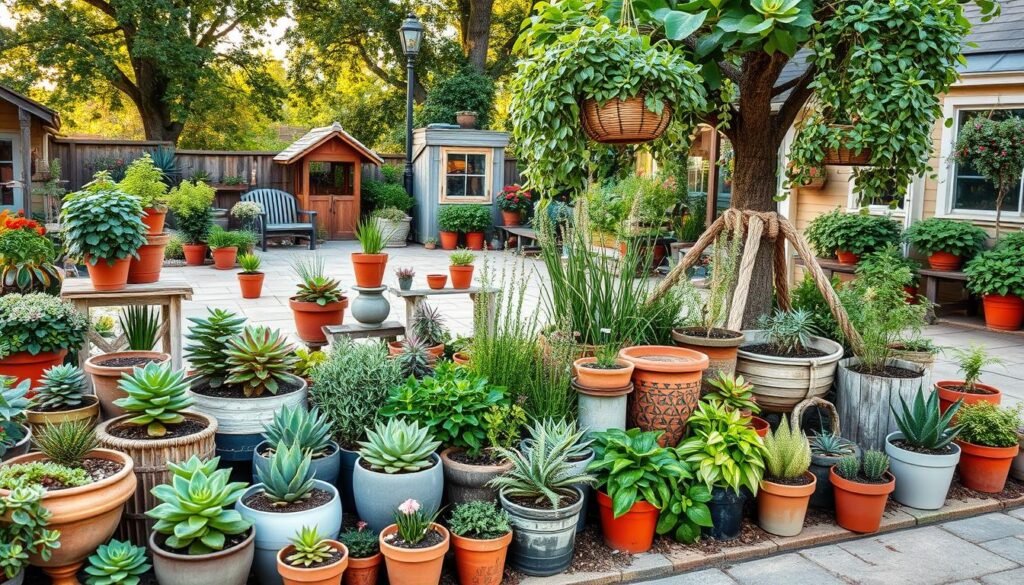
Repurposing Everyday Items
Repurposing items as planters is another creative idea. You can use old boots, bottles, or other items as planters. This adds a personal touch and helps reduce waste.
For example, make a bottle garden by filling bottles with soil and plants. Clean and dry the bottles, add rocks, and fill with soil and plants. Hang them to create a stunning display.
Colorful Plant Combinations
Container gardening lets you mix and match plants for a beautiful display. You can add color, texture, and depth to your space. This makes your outdoor or indoor area more appealing.
To create a stunning combination, think about the plants’ colors, textures, and growth habits. Mix flowering plants with foliage or succulents with herbs. This creates a unique and beautiful display.
| Plant Type | Container Type | Benefits |
|---|---|---|
| Flowering Plants | Colorful Pots | Adds color and vibrancy |
| Succulents | Repurposed Containers | Low maintenance and water-efficient |
| Herbs | Vertical Gardens | Provides fresh herbs for cooking |
By using these creative ideas, you can make your garden more beautiful and functional. Container gardening is fun for both seasoned and new gardeners. It offers endless possibilities to explore and enjoy.
Building Your Own Raised Garden Beds
Creating your own raised garden beds is a fun and rewarding DIY project. Raised beds help with drainage and soil quality, making them key for an easy DIY garden. By making your own, you can tailor the soil to your plants’ needs, leading to a healthier garden.
Materials Needed
To begin, gather a few basic items. You’ll need:
- Untreated wood planks or composite materials for the frame
- Wood screws or nails for assembly
- Weather-resistant wood glue
- Soil and compost for filling the beds
Picking the right materials is key for your raised beds’ health and life span. Opt for recycled or eco-friendly materials to follow DIY organic garden values.
| Material | Description | Benefits |
|---|---|---|
| Untreated Wood | Durable and resistant to rot | Long-lasting, eco-friendly |
| Composite Materials | Low maintenance, durable | Resistant to pests and decay |
Step-by-Step Instructions
Here’s how to build your raised garden beds:
- Plan your raised bed’s size and location, ensuring it gets the right amount of sunlight.
- Cut the wood or composite materials according to your plan.
- Assemble the frame using wood screws or nails, and apply weather-resistant wood glue for added durability.
- Fill the bed with a mix of soil and compost, tailored to the needs of your plants.
By following these steps, you can make a garden that’s better for drainage and soil. This project is a great easy DIY garden idea to improve your gardening.
Building your own raised garden beds is a rewarding project. It can greatly improve your gardening experience. By picking the right materials and following simple steps, you can create a garden that’s healthier and more productive. This project fits well with the DIY organic garden principles, letting you customize your garden to your liking.
Designing a DIY Garden Pathway
Creating a DIY garden pathway is a great way to make your garden unique. A well-made pathway not only looks good but also helps guide visitors. It’s important to think about both how it looks and how it works.
Choosing the Right Materials
The materials you pick for your pathway matter a lot. You can use traditional options like stone, brick, or concrete. Or, you can try something different with recycled materials. Using recycled items can make your pathway both unique and eco-friendly.

Think about your garden’s style when picking materials. For a rustic feel, gravel or decomposed granite might be best. For something more formal, brick or stone pavers are good choices. Mixing different materials can also make your pathway stand out.
Ideas for Pathway Patterns
The pattern of your pathway can make your garden even more interesting. You can go for a simple path or try something more complex. A winding path can lead visitors on a journey, while a straight path can highlight a special spot.
Some popular patterns include:
- A simple straight path
- A meandering winding path
- A circular pattern around a garden feature
- A stepped pathway with landings
When designing your pathway, think about adding other DIY touches. A trellis or a garden bench can make your “Yard Diy” project even better.
DIY Composting for Garden Health
To have a lush and vibrant garden, focus on the soil. Composting is key for garden health. It’s vital for a thriving outdoor space.
Composting breaks down organic materials into a nutrient-rich soil amendment. It’s great for your garden, whether you’re new to hydroponic gardening for beginners or small vegetable gardens. It makes soil fertile and structured.
Benefits of Composting
Composting has many benefits for your garden. It improves soil structure, fertility, and health. Adding compost to your soil can:
- Improve soil drainage and aeration
- Increase the soil’s water-holding capacity
- Support beneficial microbial activity
- Reduce soil erosion and compaction
It’s also good for bucket gardening. It helps create a nutrient-rich growing medium for plants.
Simple Compost Bin Ideas
Making a compost bin is easy and needs little materials. Here are some simple ideas to start:
| Compost Bin Type | Materials Needed | Benefits |
|---|---|---|
| Wire Mesh Bin | Wire mesh, wooden stakes | Easy to construct, good aeration |
| Plastic Bin | Plastic container, lid | Durable, pest-resistant |
| Wooden Pallet Bin | Wooden pallets, wire | Recycled materials, good aeration |
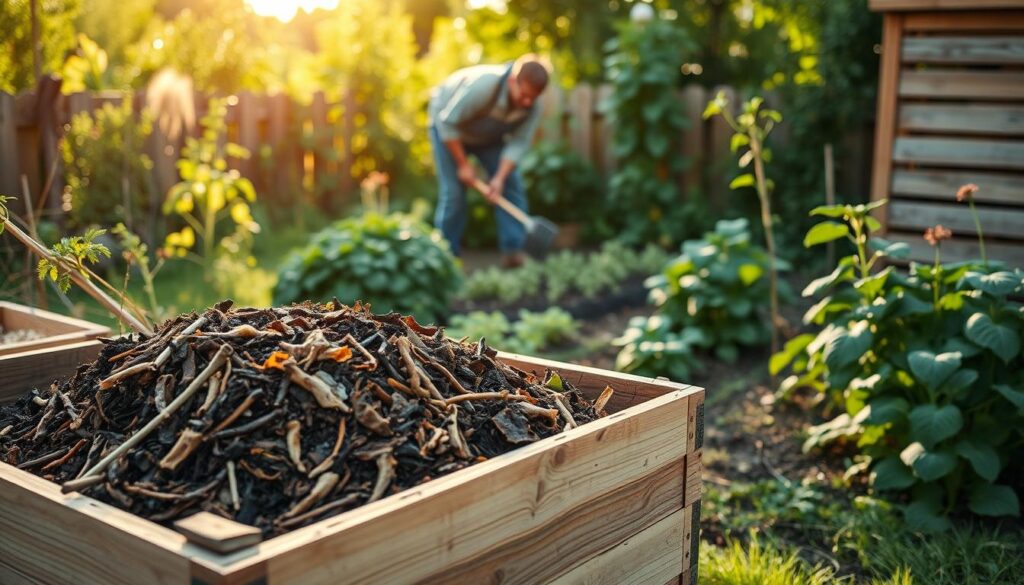
With a composting system, you can have a healthier, sustainable garden. It will thrive all year.
Crafting Unique Planters
Make your garden stand out with custom, handmade planters. Crafting your own planters is a fun DIY project. It lets you add a personal touch to your outdoor space. You can use materials like cinder blocks and wood to create both functional and decorative planters.
Using cinder blocks gives your garden a modern, industrial look. These blocks are versatile and can be stacked to create unique planters. They’re great for succulents or herbs, adding beauty and low maintenance to your garden. For a polished look, paint the blocks in a color that matches your garden’s style.
Using Cinder Blocks
Cinder blocks can be used in many planter designs. You can stack them to make a tiered planter, perfect for showing off plants. They also work well as a border around a garden bed, adding a decorative touch.
- Stack cinder blocks to create a tiered planter.
- Use cinder blocks to create a border around a garden bed.
- Paint the cinder blocks to match your garden’s color scheme.
Creating Wooden Planters
Wooden planters offer a warm, natural look. You can make one using reclaimed wood or cedar, which resists rot and insects. Adding DIY painted rocks for garden decoration can make it even more appealing.
To make a wooden planter, pick the wood you like. Cut it to size and assemble the planter with screws or nails. Don’t forget to protect the wood to prevent rot and extend its life.
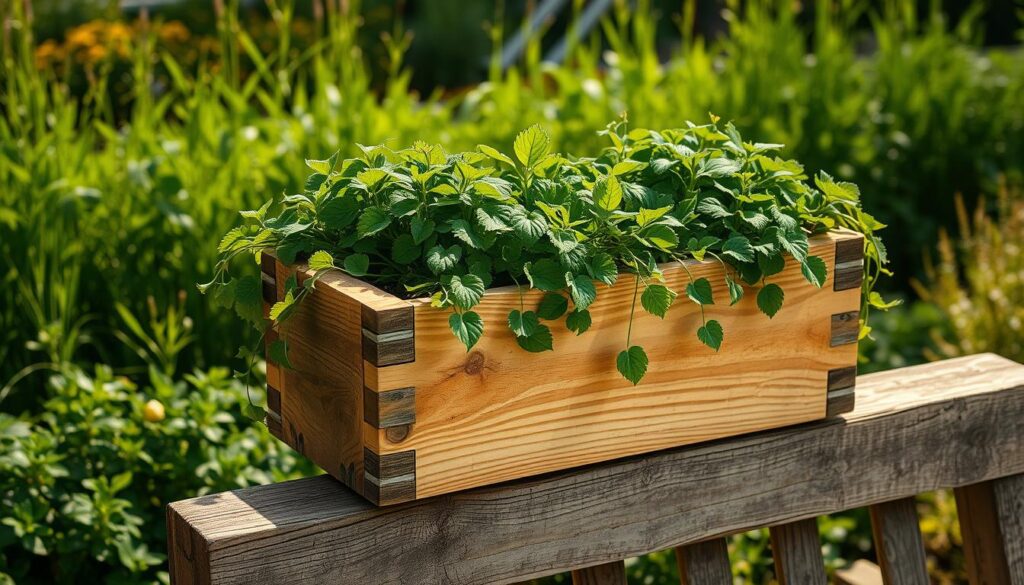
Whether you use cinder blocks or wood, making your own planters adds a personal touch to your garden. You can also add other DIY elements, like a dish garden, for a unique and appealing display.
Watering Solutions for Your Garden
Keeping the right moisture levels is key for a healthy garden. It’s important to water efficiently. There are many DIY ways to make sure your garden gets the right amount of water.
DIY Irrigation Systems
A DIY irrigation system can be made to fit your garden’s needs. If you’re into hydroponic gardening, a Diy Hydroponics System is a smart choice. It delivers water and nutrients right to your plants’ roots.
You can use soaker hoses or drip irrigation kits from gardening stores. For a more advanced setup, add a timer. This helps water plants consistently and saves water. It’s great for gardens with many plants that need different amounts of water.
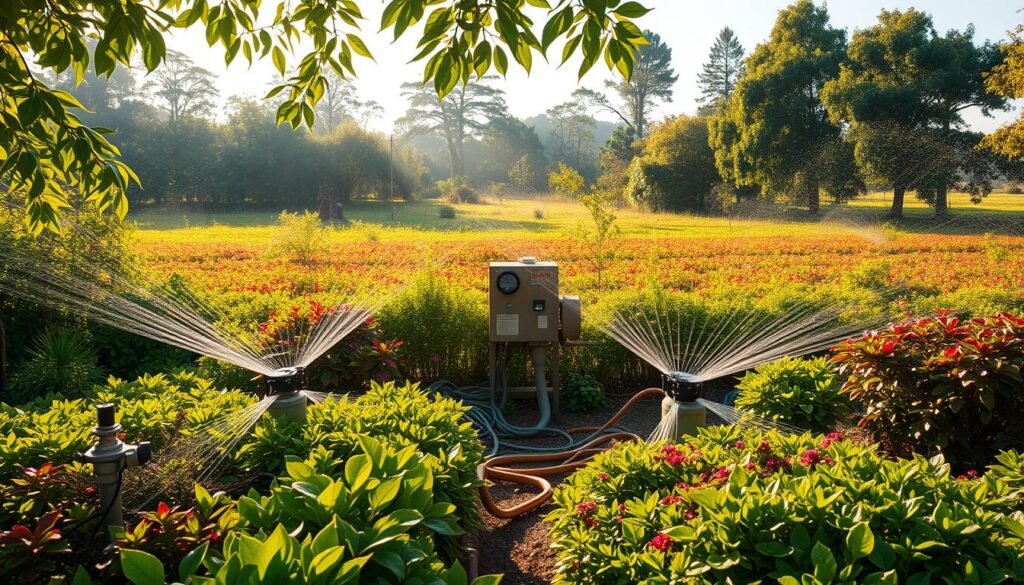
Self-Watering Planter Ideas
Self-watering planters keep moisture levels just right. They have water reservoirs that feed plants as they need it. This means you don’t have to water as often.
To make your own, use plastic containers and add a wicking system. This draws water from the reservoir to the soil. For indoor hydroponic gardening, try a Kratky Hydroponics Diy system. It’s easy to set up and doesn’t need pumps or aerators, perfect for indoor gardens.
Using these watering solutions will keep your garden healthy and lively all season long.
Adding Garden Decor and Art
Creating a beautiful outdoor space is more than just plants. It’s about adding decor and art. You can make your garden special by using decorative elements that show your style.
Stone and Pebble Designs
Using stone and pebble designs can make your garden stand out. These natural materials can create stunning patterns or features. For example, you can make a pebble mosaic or use stones to mark a garden path.
Benefits of Stone and Pebble Designs:
- Durability: Stones and pebbles are weather-resistant and last long.
- Low Maintenance: They need little care, as they don’t need watering or pruning.
- Aesthetic Appeal: They add texture and interest to your garden.
Upcycled Art Projects
Upcycled art projects can also make your garden unique. By using old items, you can create special pieces. For example, an old wheelbarrow can become a planter, or broken ceramics can make a mosaic.
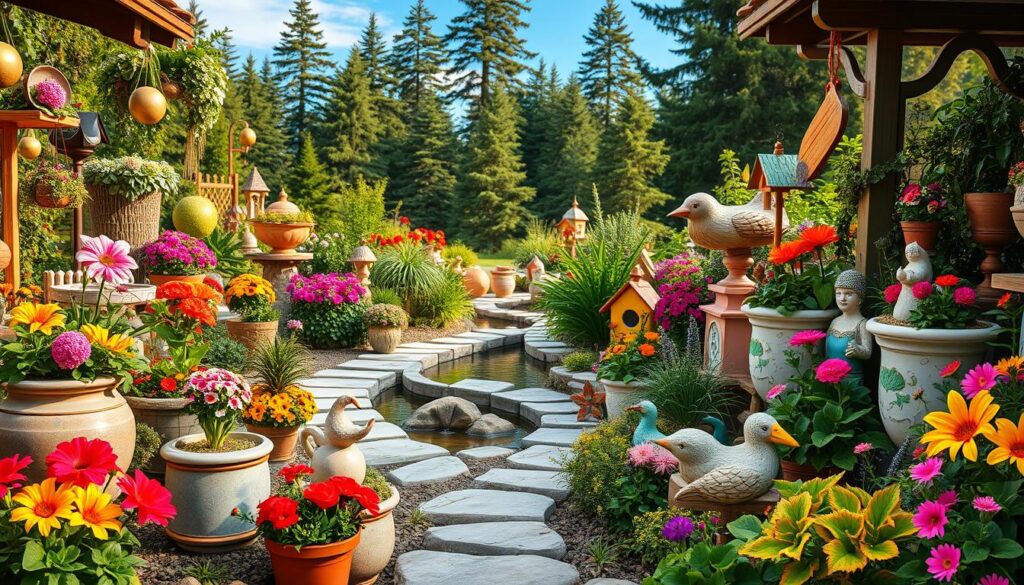
When doing DIY garden decor, think about your garden’s theme and style. This ensures your decor fits well with your garden, making it welcoming and beautiful.
| Decor Idea | Materials Needed | Skill Level |
|---|---|---|
| Pebble Mosaic | Pebbles, sand, frame | Intermediate |
| Upcycled Planter | Old container, paint, soil, plants | Beginner |
| Stone Pathway | Stones, gravel, sand | Intermediate |
By adding these garden decor and art ideas, you can make your outdoor space truly special. It will show your personal style and make your garden even more beautiful.
Seasonal Gardening Projects to Try
Whether you’re new to gardening or have been doing it for years, there’s always something new to try. Each season brings its own gardening projects. Being ready for these changes is crucial for a year-round beautiful garden.
Spring is all about planting and caring for new life. Fall is for getting your garden ready for the next year. These changes offer many opportunities for gardening.
Spring Planting Ideas
Spring is perfect for planting flowers, vegetables, and herbs. Start with easy plants like tomatoes, zucchini, and marigolds. DIY self-sustaining gardening means picking plants that need little care and fit your local climate.
- Plant a variety of flowers to attract pollinators and add color to your garden.
- Start a vegetable garden with easy-to-grow produce like lettuce, spinach, and radishes.
- Consider adding herbs like basil, mint, and cilantro to your garden for fresh flavors.

Fall Preparation Tips
As fall comes, it’s time to get your garden ready for next year. This means cleaning up, adding compost, and protecting plants from winter. Seasonal gardening means being proactive about the seasons and keeping your garden healthy all year.
- Clean up your garden by removing dead plants and debris.
- Add compost or manure to enrich the soil for the next growing season.
- Protect your plants from frost and freezing temperatures by using covers or bringing sensitive plants indoors.
By following these gardening ideas for your backyard, you can make a thriving and beautiful garden. It will bring joy and peace to your outdoor space.
Maintaining Your DIY Garden Projects
To keep your outdoor oasis thriving, regular maintenance is key. As seasons change, your garden’s needs shift. Adjusting your care routine is essential. A seasonal maintenance checklist helps your DIY garden projects flourish.
Seasonal Maintenance Checklist
To keep your garden healthy and vibrant, consider these tasks:
- Spring: Prune plants, clean up debris, and prepare soil for new growth.
- Summer: Water regularly, control weeds, and monitor for pests.
- Fall: Harvest crops, clean up fallen leaves, and prepare for winter.
- Winter: Protect plants from frost, maintain garden structures, and plan for the upcoming growing season.
By staying on top of these tasks, you can enjoy the fruits of your labor. You’ll maintain a beautiful outdoor space. For more Gardening Tips and Easy Diy Garden Ideas, explore additional resources. They can help you refine your garden planning skills.
FAQ
What are the benefits of DIY gardening projects?
DIY gardening projects bring many benefits. They help you relax and get some exercise. Plus, you can make your garden just how you like it. They’re also easy on the wallet, so more people can enjoy them.
What are the essential tools needed for DIY gardening?
Every gardener needs basic tools like a shovel, trowel, rake, and watering can. If you’re more into gardening, you might want pruning shears, garden forks, and compost turners too.
How do I plan my garden space?
First, check your garden’s environment. Look at the sunlight and soil. Then, design a layout that fits you. Pick plants that match your climate and garden conditions.
What are some creative container gardening ideas?
Try vertical gardens with trellises or wall planters. Use old boots or bottles as planters. Mix different colors and plants for a unique look.
How do I build a raised garden bed?
Start by getting wood or composite materials. Then, follow simple steps to build your raised bed.
What are some ideas for designing a DIY garden pathway?
Use stone, brick, or recycled materials for your pathway. Add a cucumber trellis for a special touch.
Why is composting important for garden health?
Composting makes your soil better and reduces the need for chemical fertilizers. It’s good for the environment and your garden.
How can I create unique planters?
Use cinder blocks or wood to make planters. Add a personal touch with painted rocks or other decorations.
What are some watering solutions for my garden?
Build a DIY irrigation system or use self-watering planters. Hydroponic gardening is another efficient option.
How can I add garden decor and art to my outdoor space?
Create patterns with stone and pebbles. Try upcycled art projects for unique decorations.
What are some seasonal gardening projects to try?
In spring, focus on planting and enjoying the growing season. In fall, clean up and protect your garden for winter.
How do I maintain my DIY garden projects?
Keep your garden in top shape with regular care. Follow a seasonal checklist and adapt to changes.







